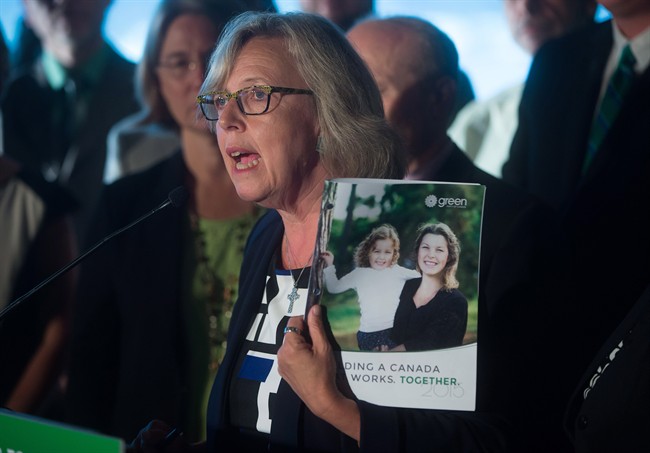OTTAWA – Three of Elizabeth May’s ancestors signed the U.S. Declaration of Independence. As a girl growing up in Connecticut, she donated her savings to help promising candidates get elected to Congress. And future U.S. president Bill Clinton wrote a recommendation letter that helped her get into law school.

So perhaps it was inevitable that May would one day find herself in the thick of party politics – albeit in her adopted homeland north of the border.
Since becoming Green party leader nine years ago, May, 61, has won a seat in the House of Commons and – sometimes through sheer force of personality – a voice in the national conversation.
READ MORE: Strategic vote key in battleground British Columbia
She now faces her toughest test: gaining the support of enough voters to parlay a parliamentary foothold of two seats – Ontario MP Bruce Hyer is the only other Green member – into a more influential presence.
As the campaign began, the party set an informal goal of about 16 seats – hoping to build in British Columbia on the strength of May’s 2011 Vancouver Island breakthrough as well as in other pockets around the country.
Twelve seats would confer official party status and the additional resources that go with it.
The party has fielded many competitive candidates – including former meteorologist Claire Martin and one-time journalist Jo-Ann Roberts in B.C., as well as former Ontario environment commissioner Gord Miller in Ontario.
READ MORE: How Global News is covering the 2015 Canadian federal election
But as election day looms, May could find herself the lone Green victor as frustrated progressive voters bent on ousting the Conservatives strategically turn to Liberal or New Democrat candidates.
The Green party’s overriding electoral goal is to have enough MPs to sway decision-making in what many expect to be a minority Parliament.
The Greens have made it clear they’re willing to work with the Liberals or NDP on issues including electoral reform, climate change and pharmacare. That co-operation could turn out to be largely symbolic if May’s dream of a bigger caucus doesn’t materialize.
READ MORE: Here’s what Harper, Mulcair, Trudeau, May and Duceppe have promised voters
Even so, collaboration is fundamental to May’s approach.
“My vision comes from an unusually political childhood, an activist upbringing, and a deep love of democracy,” she wrote in her 2014 book, “Who We Are: Reflections on My Life and Canada.”
“It comes from knowing that working together changes the world.”
READ MORE: Liberals continue to surge, widen lead in seat projections
May was born in the United States and spent her formative years there. Her mother was active in the peace and civil rights movements as well as political campaigning – efforts that left an indelible mark on the young Elizabeth growing up in rural Connecticut.
One day the family’s beloved lamb died mysteriously. In junior high school years later, May read about pesticide poisoning of sheep in Arizona. Her inquiry to the town of Bloomfield, Conn., revealed that pesticides had indeed been sprayed along the roads where the lamb liked to walk.
An environmentalist was born, and the experience would lead May to an instrumental role in the movement against planned aerial insecticide spraying on Nova Scotia forests.
May came to Canada as a teenager in 1972 when her family – struck with the beauty of Cape Breton – opened a restaurant on the Cabot Trail.
The family’s meagre finances prevented May from doing undergraduate studies, but she later won special admission to Dalhousie University in Halifax, where she earned a law degree.
In 1986 she became a senior policy adviser to Tom McMillan, environment minister at the time in the Progressive Conservative government of Brian Mulroney. May was hired despite her lack of party credentials precisely because she was the sort of person who would quit on principle – which she did after two years.
While there, however, she helped create several national parks and was involved in negotiating the Montreal Protocol to protect the ozone layer.
Work on many environmental, consumer and aboriginal causes followed. May left her job as executive director of the Sierra Club of Canada in 2006 to successfully run for the Green party leadership.
She is an energetic parliamentarian and passionate orator who relishes the opportunity to participate in question period. May is also a stickler for decorum who will sit down if heckled, waiting for the Speaker to restore order.
That respect for tradition made May’s much-publicized rant at this year’s press gallery dinner seem out of character. Tired and appearing over-refreshed, she profanely admonished the Harper cabinet before being whisked off stage and later apologizing.
Being leader of a party of just two MPs meant she must stay apprised of all key issues. With no public safety critic in her tiny caucus, she spent hours in committee last spring proposing amendments to the government’s omnibus security bill.
May’s depth of knowledge “is unlike any politician I’ve ever met,” said Mark Neufeld, a Victoria high-school teacher who has invited her to speak several times.
He recalls one bright student asking her to explain in five minutes or less how to tackle climate change at a national level.
“And I watched her do it on the whiteboard,” Neufeld said. “And I’d never seen anything like that. I was just so impressed at her willingness to do it, and not sort of give a trite answer.”




Comments